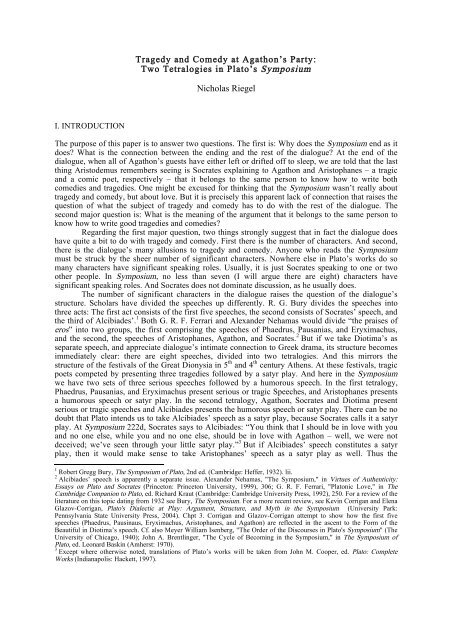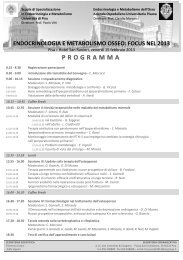Create successful ePaper yourself
Turn your PDF publications into a flip-book with our unique Google optimized e-Paper software.
I. INTRODUCTION<br />
Tragedy and Comedy at Agathon’s Party:<br />
Two Tetralogies in Plato’s <strong>Symposium</strong><br />
Nicholas Riegel<br />
The purpose of this paper is to answer two questions. The first is: Why does the <strong>Symposium</strong> end as it<br />
does? What is the connection between the ending and the rest of the dialogue? At the end of the<br />
dialogue, when all of Agathon’s guests have either left or drifted off to sleep, we are told that the last<br />
thing Aristodemus remembers seeing is Socrates explaining to Agathon and Aristophanes – a tragic<br />
and a comic poet, respectively – that it belongs to the same person to know how to write both<br />
comedies and tragedies. One might be excused for thinking that the <strong>Symposium</strong> wasn’t really about<br />
tragedy and comedy, but about love. But it is precisely this apparent lack of connection that raises the<br />
question of what the subject of tragedy and comedy has to do with the rest of the dialogue. The<br />
second major question is: What is the meaning of the argument that it belongs to the same person to<br />
know how to write good tragedies and comedies?<br />
Regarding the first major question, two things strongly suggest that in fact the dialogue does<br />
have quite a bit to do with tragedy and comedy. First there is the number of characters. And second,<br />
there is the dialogue’s many allusions to tragedy and comedy. Anyone who reads the <strong>Symposium</strong><br />
must be struck by the sheer number of significant characters. Nowhere else in Plato’s works do so<br />
many characters have significant speaking roles. Usually, it is just Socrates speaking to one or two<br />
other people. In <strong>Symposium</strong>, no less than seven (I will argue there are eight) characters have<br />
significant speaking roles. And Socrates does not dominate discussion, as he usually does.<br />
The number of significant characters in the dialogue raises the question of the dialogue’s<br />
structure. Scholars have divided the speeches up differently. R. G. Bury divides the speeches into<br />
three acts: The first act consists of the first five speeches, the second consists of Socrates’ speech, and<br />
the third of Alcibiades’. 1 Both G. R. F. Ferrari and Alexander Nehamas would divide “the praises of<br />
eros” into two groups, the first comprising the speeches of Phaedrus, Pausanias, and Eryximachus,<br />
and the second, the speeches of Aristophanes, Agathon, and Socrates. 2 But if we take Diotima’s as<br />
separate speech, and appreciate dialogue’s intimate connection to Greek drama, its structure becomes<br />
immediately clear: there are eight speeches, divided into two tetralogies. And this mirrors the<br />
structure of the festivals of the Great Dionysia in 5 th and 4 th century Athens. At these festivals, tragic<br />
poets competed by presenting three tragedies followed by a satyr play. And here in the <strong>Symposium</strong><br />
we have two sets of three serious speeches followed by a humorous speech. In the first tetralogy,<br />
Phaedrus, Pausanias, and Eryximachus present serious or tragic Speeches, and Aristophanes presents<br />
a humorous speech or satyr play. In the second tetralogy, Agathon, Socrates and Diotima present<br />
serious or tragic speeches and Alcibiades presents the humorous speech or satyr play. There can be no<br />
doubt that Plato intends us to take Alcibiades’ speech as a satyr play, because Socrates calls it a satyr<br />
play. At <strong>Symposium</strong> 222d, Socrates says to Alcibiades: “You think that I should be in love with you<br />
and no one else, while you and no one else, should be in love with Agathon – well, we were not<br />
deceived; we’ve seen through your little satyr play.” 3 But if Alcibiades’ speech constitutes a satyr<br />
play, then it would make sense to take Aristophanes’ speech as a satyr play as well. Thus the<br />
1 Robert Gregg Bury, The <strong>Symposium</strong> of Plato, 2nd ed. (Cambridge: Heffer, 1932). lii.<br />
2 Alcibiades’ speech is apparently a separate issue. Alexander Nehamas, "The <strong>Symposium</strong>," in Virtues of Authenticity:<br />
Essays on Plato and Socrates (Princeton: Princeton University, 1999), 306; G. R. F. Ferrari, "Platonic Love," in The<br />
Cambridge Companion to Plato, ed. Richard Kraut (Cambridge: Cambridge University Press, 1992), 250. For a review of the<br />
literature on this topic dating from 1932 see Bury, The <strong>Symposium</strong>. For a more recent review, see Kevin Corrigan and Elena<br />
Glazov-Corrigan, Plato's Dialectic at Play: Argument, Structure, and Myth in the <strong>Symposium</strong> (University Park:<br />
Pennsylvania State University Press, 2004). Chpt 3. Corrigan and Glazov-Corrigan attempt to show how the first five<br />
speeches (Phaedrus, Pausinaus, Eryximachus, Aristophanes, and Agathon) are reflected in the ascent to the Form of the<br />
Beautiful in Diotima’s speech. Cf. also Meyer William Isenberg, "The Order of the Discourses in Plato's <strong>Symposium</strong>" (The<br />
University of Chicago, 1940); John A. Brentlinger, "The Cycle of Becoming in the <strong>Symposium</strong>," in The <strong>Symposium</strong> of<br />
Plato, ed. Leonard Baskin (Amherst: 1970).<br />
3 Except where otherwise noted, translations of Plato’s works will be taken from John M. Cooper, ed. Plato: Complete<br />
Works (Indianapolis: Hackett, 1997).




